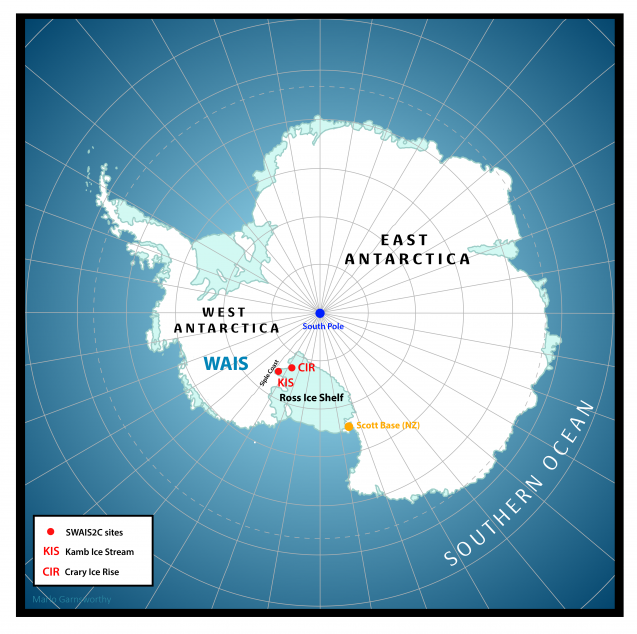In Massive Project, Scientists to Probe Deposits Beneath West Antarctic Ice Sheet
Drilling into sub-ice deposits left behind during times when the Earth was warmer than today should provide insights into how a massive ice sheet will react to human-induced climate change.

Recent research suggests it is inevitable that the warming Southern Ocean will speed up melting of the West Antarctic Ice Sheet regardless of future carbon dioxide emissions. This region holds enough ice to raise sea level by 5 meters if completely melted. But while we know sea-level rise is coming from this source, we aren’t yet certain how much and how fast. An international project known as SWAIS2C aims to clarify this question by drilling into sediments under the ice.
One major question: when and under what climatic conditions the large floating ice shelves at the edges of the ice sheet will be lost. This is vital, because the ice shelves act as buttresses, stabilizing the inland ice pressing behind them. To help answer this question, scientists will turn to the geological record and recover sediments deposited during past times when it was warmer than today. These sediments hold environmental information that until now has been impossible to obtain.
“We know more about the rocks and composition of the moon than we do about the land beneath the West Antarctic Ice Sheet,” said Richard Levy, co-chief scientist of SWAIS2C, which stands for Sensitivity of the West Antarctic Ice Sheet to 2 Degrees C of Warming. So far, researchers have recovered geological samples from only 13 locations beneath the ice blanketing West Antarctica.
In addition to new observations, the SWAIS2C project will employ numerical models of the ice sheet, its surrounding oceans, and the underlying earth. “Combining observations with models will help us understand the underlying processes and thresholds that led to ice collapse or stability in the past,” said geodynamicist Jacqueline Austermann of Lamont-Doherty Earth Observatory, a member of the SWAIS2C modeling team. “Models will be at the heart of quantitatively connecting observations from the distant geologic past to predicting future change.”
A team of drillers, engineers and researchers will travel to the southeast margin of the Ross Ice Shelf, which hangs off the ice sheet. There, they will drill up to 200 meters below the seafloor to recover a geological record of changing rock types that reflect environmental conditions at the time they formed. The team will use a custom-built hot-water drill to melt a 35-centimeter diameter hole through some 600 meters of ice to access the cavity near where land ice begins to float and form an ice shelf. They will then position a special sediment coring system over the hole, lower a diamond-studded hollow drill bit to the ocean floor, and drill down.
Field operations are scheduled to begin in November 2023. A second field season will begin in November 2024 at a separate location.
More than 120 people from some 35 international research organizations are collaborating on the project. SWAIS2C brings together researchers from New Zealand, the United States, Germany, Australia, Italy, Japan, Spain, Republic of Korea, the Netherlands, and the United Kingdom. The team includes glaciologist Jonathan Kingslake, ocean-sediment expert Brendan Reilly and geochemist Sidney Hemming, all from Lamont-Doherty. Other U.S. institutions involved include Binghamton University, Central Washington University, Colgate University, the Colorado School of Mines, Purdue University and Ohio State University.
Adapted from a press release by SWAIS2C.
